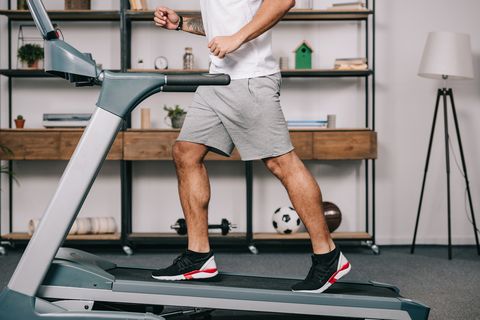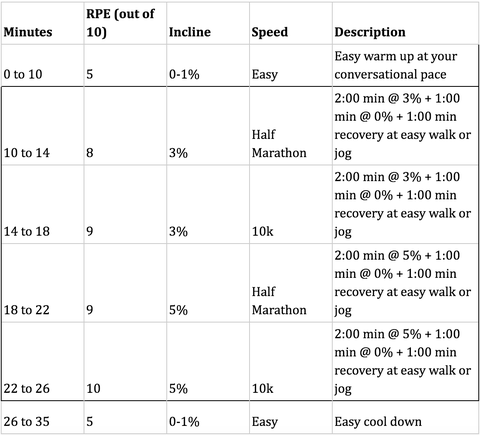Everyone has a different go-to workout. Regardless of what that is for you, there’s no denying that you can get a pretty good sweat in on the treadmill.
While you might prefer to log your runs outdoors and soak in some essential vitamin D, picking things up on the tread allows you to take your workout to the next level. Plus, according to research published in the International Journal of Research in Exercise Physiology, treadmills give you the most bang for your buck over other pieces of cardio equipment, including rowers, bikes, and ellipticals.
“The tread is not only your friend, but it’s a tool in your training toolbox,” says Jes Woods, regional manager group treadmill studio Mile High Run Club (MHRC) and Nike Running coach. “You can dial in exact speed and incline, eliminating guesswork of GPS watches and dodging traffic and stop lights.”
And to those who say it’s oh-so-boring? Woods says it’s about time you shift your mindset. “The ‘dreadmill’ is only boring if you make it boring, running at a single speed or incline counting down the minutes. But when you’re constantly changing gears and playing with pace and effort, the time flies by.”
Ready to hop on and actually get some training done? Here are eight different treadmill workouts, guaranteed to give you a real running challenge and a stellar calorie burn.
The Glossary
Conversational pace: An effort that you can endure for long periods of time in which it would be easy to maintain a conversation with a friend.
Rate of perceived exertion (RPE): RPE is a way of internally scanning the body and accessing how hard you’re working. Typically, the scale is based on factors like muscle fatigue, increased heart rate, and perspiration rate. An RPE of 0 is nothing—as in you could literally be sprawled out on the couch. Shift gears to a RPE of 5, and you’ll feel moderately taxed. You definitely know you’re exercising, but can handle the effort for a long time. You can top out at 10, where you feel like you’re pushing things to the max. Nausea? Maybe.
Popular Q: Should I be setting my tread incline to 1 percent?
Answer: Research shows that a treadmill at a 1 percent incline will more closely simulate the “energetic cost” (or intensity) of outdoor running. This added incline makes up for the lack of wind resistance. Woods agrees, saying that the 1 percent setting is common practice at MHRC. If your machine has the ability to incline, consider that 1 percent as another way to make the workout more natural.
Want to get running inside, but don’t have a treadmill? Check out our picks for some of the best machines you can get for your home gym.
The Treadmill Workouts

LightFieldStudiosGetty Images
Speed Intervals One
Duration: 30 to 40 minutes

Men’s Health
Coach says: This is a short, fast, and spicy workout simulating 200-meter repeats on the track. The intervals are short, so could you run them faster? Sure! But that’s not the point of the workout. We want you to stay in control with the 1 minute pushes. Looking to make things more difficult? Advanced runners can run 12 to 14 x 1 minutes on.
Speed Intervals Two
Duration: 45 minutes

Men’s Health
Coach says: Fast, faster, fastest! Start smooth and in control with 3 minutes at half marathon pace (7 out of 10 effort). The first interval should feel almost like an extension of your warm up. Then, gradually ease on the gas pedal feeling your stride start to gradually open up as well. The hardest part of the workout is not getting faster then fastest, but rather backing off the gas pedal and going back to smooth, and in control half marathon pace. Advanced runners can repeat the above sequence 4 times total.
Fartlek Workout
Duration: 35 minutes

Men’s Health
Coach says: This workout is much more unstructured, so have fun with it. Instead of counting down the seconds on the console, simply speed up with the music picks up and ease off the gas pedal with tempo slows. Try to keep the 15-minute workout portion continuous. Jog the recoveries, walk if you have to, but no standing rest. Advanced runners can increase the Fartlek workout portion to 20 minutes.
Half Marathon Workout
Duration: 55 minutes

Men’s Health
Coach says: We’re simulating 1K intervals with this workout. An important note: You should not be totally breathless at Half Marathon Pace (HMP) or 7 out of 10 effort. Rather, you’re edging close to your tempo pace of threshold effort, so it should feel mildly uncomfortable. We want you to look so relaxed at half marathon pace that it looks like your recovery pace. The 2-minute recovery might feel like an eternity, so walk until your breath comes back to you, then transition to an easy jog recovery. Beginner runners can modify to 3 to 4 x 5 minute half marathon pace (if you know it)—or 7 out of 10 effort.
Hills Workout One
Duration: 45 minutes

Men’s Health
Coach says: Bring on the hills! The 6 minutes of rolling hills should be run at half marathon pace. Advanced runners can bump up the speed for the final 3 percent at the end of each sequence. Changing the incline every minute is going to keep you engaged and eliminate any chance of treadmill boredom. Feel yourself leaning into the inclines, hinging at your ankles, not your waist. On the incline, shorten your stride to a quicker cadence (popping off the treadmill like the tread is lava). Once back on flat ground, open the stride back up and shake it out.
Hills Workout Two
Duration: 35 minutes

Men’s Health
Coach says: “Up and over” hills are my favorite workout because it’s a real life scenario. In races, we don’t sprint to the top of a hill and stop and recover—we have to keep running. This workout will work some mental toughness (in addition to physical) to convince your legs to continue turning over once you crest the hill. On the incline, shorten your stride to a quicker cadence (popping off the treadmill like the tread is lava). It’s okay to be out of breath running the hills at 10k pace, you should be. As you become fatigued with this workout, pay close attention to form. Try not to carry your arms, but drop them down at your side and use them to power up the hill. Advanced runners can run through the hill sequence a second time.
Endurance Run
Duration: 50 minutes

Men’s Health
Coach says: During the 30-minute chunk of this workout, you’re aiming to progress through each 8-minute block. This looks like 2:00 at marathon pace (RPE 6), 2:00 at half marathon pace (RPE 7), 2:00 at 10k pace (RPE 8), 2:00 at 5K pace (RPE 9). Advanced runners can modify the final 2 minutes to be 1 minute at 5K pace and a final 1 minute at an all-out pace. Remember: patience is key. You don’t want to start off too fast and die a slow death. Use the first 2 minutes as an additional warm up, you should still be conversational at 6 out of 10 effort marathon pace for 2 minutes. Start slow and in control, ending the final 8-minute block with your biggest most beautiful stride. Beginner runners can complete 2 x 8 minute builds.
HIIT Run
Duration: 40 minutes

Men’s Health
Coach says: Since the workout is short and fast and breathless, we want to ensure you’re properly warmed up for this one. Get really ready for the pending efforts in the final two minutes of your warm up by throwing in some 20-second striders. For the efforts, aim to start at 5K pace and end at mile pace. Instead of all out effort on flat ground for 30 seconds, if you’d like to switch up the workout during one of the rounds, try running half marathon pace up an 8 percent incline for 30 seconds on. Unlike our other workouts, it’s okay to not be fully recovered in the 30 seconds off. That’s the whole point! We want to get the heart rate up and keep it up. Beginners can run through the sequence 2 to 3 times total.

Source: Read Full Article
